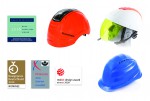Ensuring cobot safety
Published: 08 September, 2021
Collaborative robots are designed to operate safely alongside humans, but there are still precautions and procedures that you need to implement to minimise risks. Peter Lange* explains.
Collaborative robots (cobots) are a key aspect of Industry 4.0 and the factory of the future. They have various integral safety features, allowing them to work with, or near, people and they can also adapt easily to changing needs. This means that the productivity of many repetitive tasks can be increased significantly, enabling users to obtain a rapid return on their investment.
For a cobot application to succeed, it must incorporate safety considerations based on comprehensive risk assessments. So, what are the safety standards and solutions that will allow manufacturers to gain the maximum value from cobots used in collaborative workspaces?
Safety standards
Cobots are usually smaller than conventional robots and incorporate force and speed monitoring capabilities. If linked to safety devices that detect people entering the workspace, they can often work at higher speeds when people aren’t present, helping to increase throughput.
Two key safety standards that define the safety functions and performance of cobots are ISO 10218 parts 1 and 2, and ISO TS 15066. The latter sets force and speed monitoring of the cobot based on application data, human contact area and workspace hazards. There are two types of human contact: transient (nontrapping contact); and quasi-static (involving situations that can cause a body part to be trapped).
If you aren’t familiar with the requirements of ISO TS 15066, you can hire a safety assessment provider to do the calculations, take measurements, and recommend improvements to the safety of the application.
Safe teaching and operation
Before being taught, a robot must be stopped before the operator enters its workspace, even if its force- and speed-limiting functions have been activated. Alternatively, a safety device – such as an area scanner – must perform a protective stop as soon as the operator is detected.
If safety force and speed monitoring are in operation, the operator can use a simple trigger, button or mode selector to activate teaching. If not, a three-position safety enable is required. According to the safety standards, the teaching mode transition: must be deliberate; must not lead to any unexpected motion; and must not create additional hazards. At all times, the operator should be aware of surrounding equipment and possible safety issues. To enhance operator safety, it is possible to enforce limits on motion – for example, space and soft axis limits.
Before operation, the operator must vacate the safeguarded space. This can be verified by safety sensors or additional operator verification. Intentional mode selection is needed to re-enable the robot for operation.
Other equipment
Cobots may be operating near other equipment that could be dangerous. It is therefore important to list and map out all additional equipment in the collaborative workspace (which must be marked clearly). Each device must be assessed for potential hazards and for safety sensors that could prevent human and equipment damage.
Types of non-collaborative equipment that might need safety devices include: material handling; tooling; grippers and actuators; and machines. Safety devices can usually be integrated easily into a cobot application.
There are several ways to safeguard a collaborative workspace. In open areas and applications with low hazards, these include safety area scanners and mats. In gated or limited areas with more hazardous applications or high-speed operations, safety light curtains and safety switches can be used. In areas with active hazards or operations that could cause a hazard, operators can enable a “dead man’s switch”, which turns off automatically if the user stops exerting pressure on it.
For maximum safety in collaborative operations, manufacturers must validate the safety of their cobot applications across all operations. There are some guidelines they can follow when evaluating the safety of a robot while performing a given task with a human operator. Some dangers, such as drive and power hazards, might still exist even if the robot isn’t moving.
Operator safety
Before starting a cobot or recovering from an emergency stop, an intentional act is needed to enable the robot, to protect operators. For example, if an operator activates an e-stop, the robot should not be able to re-enable automatically, but should first need verification from a second operator.
During the design and safety set-up phases, hand guiding must be allowed only if the robot has stopped, there has been intentional mode selection, and speed and force monitoring are active. If hand guiding is activated without a stop command or safety input, this should initiate a safety stop and fault.
To operate a cobot automatically, the operator must make an intentional mode selection that requires all safety devices and conditions to be validated. For validation, a safety assessment review should be made of the surrounding areas and equipment and, if necessary, a safety remediation service performed. Safety service groups should make on-site inspections of the safety of equipment, confirm certifications, verify safety parameter settings and finally document the completion of the validation. Different types of application required different safety considerations.
Machine tending applications are a top concern, according to safety experts. For maximum safety, manufacturers should use safetyrated grippers to protect operators against injury. They should also investigate whether the products being handled present any dangers (such as extreme heat or sharp edges).
Material-handling applications that can benefit from using cobots include picking, packing, palletising and sorting. The wide use of these applications makes safety site-specific. Operators and other workers often move or transport materials around a cobot, so planning is needed to avoid hazardous contacts. Assembly applications using cobots often require special tooling and close collaboration with operators, while also requiring high-speed operation zones. The wide variety of custom end-of-arm tooling makes these applications especially complex.
If multiple robots are involved, application designers must carefully co-ordinate the safety aspects of each one. Risk assessments Cobots are usually considered as safe for use with people. However, they still need risk assessments to ensure the safety of operators. It’s vital for manufacturers to consider all of the potential hazards associated with hand-guided teaching, as well as possible issues when a robot is involved in an emergency stop.
*Peter Lange is Omron Europe’s robotics business development manager
https://www.linkedin.com/company/omron






 Worker safety specialist ALPHA SOLWAY, part of Globus Group says Europe’s multi award-winning range of safety helmets by ENHA are now available in the UK and Ireland. The company says as a well established and respected innovator in head protection across mainland Europe with a reputation for quality and performance, ENHA’s extensive range of safety helmets has been designed to provide protection for workers across multiple sectors including construction, utilities, manufacturing, engineering, metal working and forestry.
Worker safety specialist ALPHA SOLWAY, part of Globus Group says Europe’s multi award-winning range of safety helmets by ENHA are now available in the UK and Ireland. The company says as a well established and respected innovator in head protection across mainland Europe with a reputation for quality and performance, ENHA’s extensive range of safety helmets has been designed to provide protection for workers across multiple sectors including construction, utilities, manufacturing, engineering, metal working and forestry.
